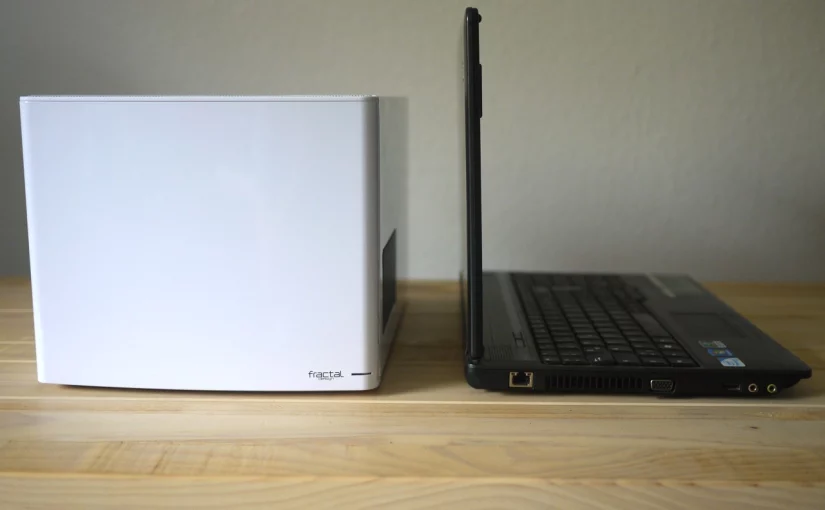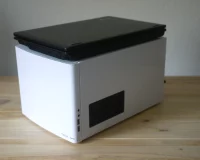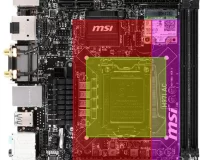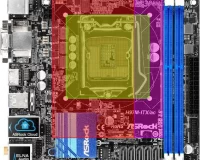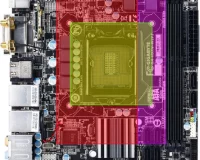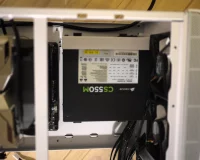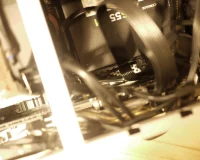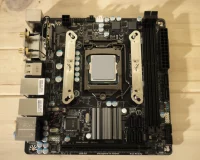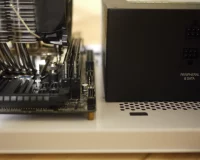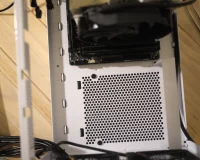If you use your laptop as a desktop replacement, you will at some point get an external display and a mouse/ keyboard for more convenient usage.
At this point the laptop becomes only a small case of non-upgradable components.
Now you could as well replace your laptop by a real case of comparable size. This will make your PC not only easily upgradable, but allow higher-end components while being more silent at the same time.
Lets start by a quick size comparison between the Fractal Design Node 304 mini ITX case and a standard 15.4″ wide-screen laptop:
As you see the case has about the same footprint and is even less high compared to the open laptop.
[toc wrapping=”right”]
Of course there are many choices of mini ITX cases – and some of them are even small than the Node 304. However I think the Node has a good balance between size and room for standard components; you will not need a ITX sized graphics card or a low profile CPU cooler. See this review for details of the case layout.
Now lets discuss what we can actually fit inside this small cube to see whether my claims about performance and volume can hold.
As it was one of the main reasons to select the case lets start with the
CPU Cooler
For CPU coolers the credo is: the bigger the better. If the heat is spread over a large area it means we need to move less air to carry it away. This again means the CPU fan does not need to spin that fast and our machine is quieter. (or can go faster at the same volume level)
The Node 304 fits CPU coolers up to 165mm height. This allows to use a tower cooler with a 140mm fan. When aligned with the 140mm rear fan of the case this will give us a nice air-flow to cool the CPU.
To use up the available space I mounted the Alpenföhn Brocken 2 which is exactly 165mm high. The included fan which spins up to 1100rpm which is in the same order as the 1000rpm rear fan of the case. Generally it is regarded as one of the best and quietest coolers in the 35€ class.
Mainboard
The main question when selecting the mainboard is where the CPU socket is located; a bad placement might block the PCIE slot and ideally the cooler should be aligned with the rear fan.
Furthermore the mainboard should include as much I/O as possible as we only have one PCIE expansion slot which will be occupied by the graphics card.
Lets take an exemplary look on the current H97 ITX board lineup. As you might have guessed, I will go with Intel, but the basic discussion also applies to AMD boards. Note that I did not bother including Asus as their board does not come with Wifi.
Green marks the extent of the LGA1150 mount holes used as reference. Red marks the extent of the Brocken 2 Cooler and pink marks the extent of the corresponding fan.
Basically both Gigabyte and ASRock would work. However the more central socket placement of Gigabyte aligns the cooler with the rear case fan which improves airflow.
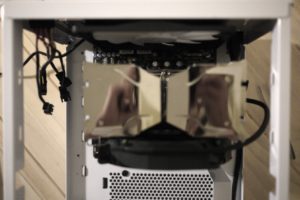
When comparing the boards with their previous H87 iteration, it is worth noting that only Gigabyte took the chance to improve their board layout. With with their H87 board they had the socket at the same bad spot as MSI.
Graphics Card
As we are building a workstation here we use a discrete gaphics card. There are several 17cm sized graphics boards available – however the small size allows using only one fan and thus the ITX sized graphics boards are considerably louder than their larger brothers. For the GTX760 the difference under load is up to 10db. Basically the same argument as with the CPU coolers applies: the bigger the better.
The Node 304 can hold graphics cards up to 300mm length. So basically we can use any graphics card we want.
Looking at the current Nvidia GTX900 series, MSI got the best cooler design with its Twin Frozr v5. The two 100mm fans are completely off when idle and still very quiet under load.
Power Supply Unit
You can use the be quiet! PSU calculator to find out the concrete PSU requirements. I ended up with 263W for the configuration described in this post. As the PSU have maximum efficiency at about 50% load, one should go with a 500-550W PSU here.
However the Node 304 imposes a restriction on the PSU length when using a discrete GPU: it may not be longer the 160mm. This means that if the PSU has cable management it must be shorter than 160mm so the cable management plugs do not interfere.
Unfortunately (for be quiet) be quiet does not offer PSUs shorter than 160mm so we go with the Corsair CS550 instead which is impressively short at 140mm while still being quiet and having a 80Plus Gold certificate.
Assembly Notes
Other components
The discussion above should give you enough hints to build your own Node 304 based workstation. But in case you are interested in my complete build or need more inspiration here are the other components I used
CPU
I go with Intel here because I need CPU power for compiling. If you just want to build a gaming box/ Steam Machine a AMD CPU is probably going to be enough.
My requirements are a quad-core with hyperthreading which basically boils down to a core i7. However there is also the Xeon E3-1231v3 which is basically a i7 without the integrated graphics. This saves 4W TDP and some money as we use a dedicated GPU anyway.
Chipset
Chipsets really do not matter much any more. The performance critical part of the chipset, the northbridge, is now on the CPU. The remaining differences between H97 and Z97 are overclocking and SLI. However SLI is moot on ITX boards anyway and overclocking is usually added by the manufacturer via their custom BIOS.
The main reason for picking H97 over H87 is that the hardware vendors had another try to improve over their previous H87 boards.
Then there is also the B85 chipset, which additionally lacks software RAID support, but otherwise would be sufficient. However none of the B85 ITX boards comes with Wifi which cancels out their price advantage. For more details on the differences between B85, H87 and Z87 see here.
